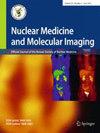Technetium 99m PSMA Superscan Mimicking a Bone Scan Gone Wrong.
IF 1.3
Q3 RADIOLOGY, NUCLEAR MEDICINE & MEDICAL IMAGING
引用次数: 1
Abstract
Imaging of metastatic castrate-resistant prostate cancer to select patients suitable for peptide receptor radioligand therapy can be performed with both SPECT and PET PSMA radiotracers. Although PET radiotracers generally have higher sensitivity and spatial resolution, SPECT tracers can be an effective alternative when PET/CT systems are unavailable in the clinical setting. We present a case of a 43-year-old male, who was referred to our facility for workup for radioligand PSMA therapy. His Tc-99m PSMA images revealed diffuse bone infiltration in a pattern mimicking a bone scan.


Technetium 99m PSMA超级扫描仪模拟骨扫描出错。
对转移性去势抵抗性前列腺癌进行影像学检查,以选择适合肽受体放射配体治疗的患者,可以同时使用SPECT和PET PSMA示踪剂。虽然PET示踪剂通常具有更高的灵敏度和空间分辨率,但当PET/CT系统在临床环境中不可用时,SPECT示踪剂可以是一种有效的替代方法。我们提出一个43岁的男性病例,他被转介到我们的设施进行放射配体PSMA治疗。他的Tc-99m PSMA图像显示弥漫性骨浸润,其模式与骨扫描相似。
本文章由计算机程序翻译,如有差异,请以英文原文为准。
求助全文
约1分钟内获得全文
求助全文
来源期刊

Nuclear Medicine and Molecular Imaging
RADIOLOGY, NUCLEAR MEDICINE & MEDICAL IMAGING-
CiteScore
2.20
自引率
7.70%
发文量
58
期刊介绍:
Nuclear Medicine and Molecular Imaging (Nucl Med Mol Imaging) is an official journal of the Korean Society of Nuclear Medicine, which bimonthly publishes papers on February, April, June, August, October, and December about nuclear medicine and related sciences such as radiochemistry, radiopharmacy, dosimetry and pharmacokinetics / pharmacodynamics of radiopharmaceuticals, nuclear and molecular imaging analysis, nuclear and molecular imaging instrumentation, radiation biology and radionuclide therapy. The journal specially welcomes works of artificial intelligence applied to nuclear medicine. The journal will also welcome original works relating to molecular imaging research such as the development of molecular imaging probes, reporter imaging assays, imaging cell trafficking, imaging endo(exo)genous gene expression, and imaging signal transduction. Nucl Med Mol Imaging publishes the following types of papers: original articles, reviews, case reports, editorials, interesting images, and letters to the editor.
The Korean Society of Nuclear Medicine (KSNM)
KSNM is a scientific and professional organization founded in 1961 and a member of the Korean Academy of Medical Sciences of the Korean Medical Association which was established by The Medical Services Law. The aims of KSNM are the promotion of nuclear medicine and cooperation of each member. The business of KSNM includes holding academic meetings and symposia, the publication of journals and books, planning and research of promoting science and health, and training and qualification of nuclear medicine specialists.
 求助内容:
求助内容: 应助结果提醒方式:
应助结果提醒方式:


